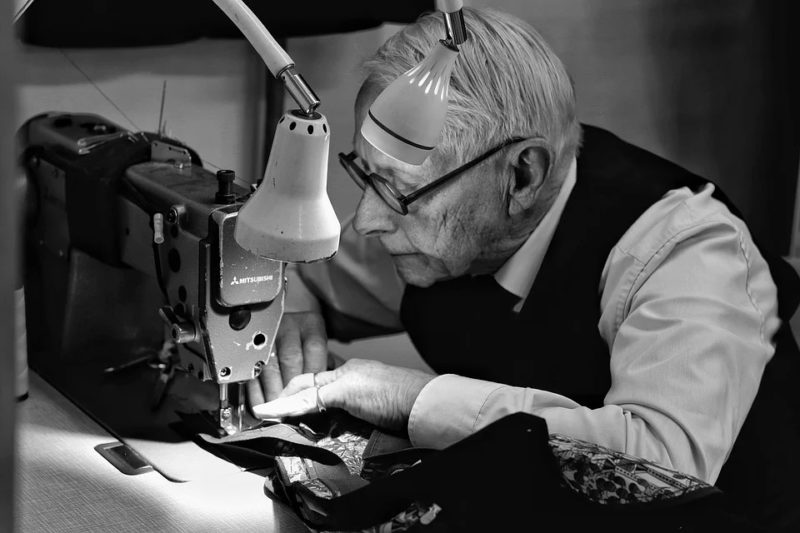Those who want to know how to release clutch on sewing machine will be pleased that it only takes two steps. We’ll start with checking the machine and then turning the handwheel. You’ll also learn a lot about the sewing machine clutch.
We highly encourage that you browse our blog for other maintenance tutorials for your sewing machine as well. You can find guides on how to clean a sewing machine, for example. Remember that proper maintenance is crucial for the machine to work well and last long.

How To Release Clutch On Sewing Machine Correctly
Step 1. Check the sewing machine
- Turn off the sewing machine when you notice the handwheel stuck
- Check the clutch, which is a large button located on the base plate
- Press the clutch down and hold it in place while you adjust the handwheel and press the machine foot
Step 2. Adjust the wheel
- Experiment with turning the handwheel towards and away from you
- You should feel the pin being engaged; then you can turn the handwheel towards you and hear a sound from it
- Once you hear a sound, this means that the pin is locked
- Release the clutch button slowly and then learn how to put a needle in the sewing machine correctly before you start practice sewing
What Is The Purpose And Function Of A Clutch?
For the stitching mechanism
The clutch of the sewing machine is also called the thumbscrew or central knob, and it controls the stitching. It is responsible for engaging and disengaging the stitching mechanism of the sewing machine. Furthermore, it helps the bobbin winder to work even when you don’t run the sewing machine itself.
For bobbin winding
For example, you wind the bobbin and then tighten the center knob afterward so the needle can move again. This is why you must check the clutch knob during winding to ensure that the needle won’t move. And if your handwheel needs tightening or loosening, you can use the clutch knob to set it.
For setting the handwheel
Start by checking if the handwheel is tight or loose and press down the clutch knob to adjust the handwheel’s grip. Hold it in place until your set the handwheel correctly, and then release the knob. However, remember to remove the needle and fabric before adjusting the handwheel with the clutch.
Where Is The Clutch On A Sewing Machine?
The clutch or thumb screw is typically located in the center of the flywheel. You can also find the button on the base plate under the arm to set the jammed handwheel. Ultimately, always refer to the specific sewing machine’s manual and study its illustrations to identify the parts.
How Does A Sewing Machine Clutch Work?
You can turn the sewing machine clutch counterclockwise to disengage it when threading the bobbin. As a thumbscrew, you can remove it as well to keep the machine from working. You also need to hold it down when setting the handwheel.
How To Fix Sewing Machine Clutch
- Remove the clutch release knob and clutch
- Reposition the clutch to adjust it before putting the knob back
- Put the screw back and remove the knob and clutch again if the screw hits something
- Reposition the clutch and place it back with the knob
- Install the screw and test the knob
What Causes A Sewing Machine Needle To Won’t Move?
A disengaged handwheel clutch can cause the sewing machine needle to won’t move. Remember that you disengaged it when you wind the bobbin, but you need to re-engage it once you’re done winding the bobbin. If this doesn’t solve the issues, check the sewing machine’s drive belt.
How Do You Adjust A Clutch Motor On A Sewing Machine?
Industrial sewing machines can either use a clutch motor or a servo motor. The former drives the sewing machine with a belt, and you can adjust this belt’s tension by loosening the nuts on the motor’s sides. However, always refer to your sewing machine manual or consult a professional if you’re not that familiar with your machine’s motor type.
What Is A Sewing Machine Clutch Motor Vs Servo Motor
- The clutch motor will run continuously once your run the industrial sewing machine, hence the consistent humming noise when working the machine
- The servo motor will only start when you press the sewing machine pedal
- The clutch motor is durable and perfect for sewing tough materials like leather quickly
- The servo motor is easier to use for beginners because you can set the speed with a switch, and it will remain constant throughout the process
- Servo motors run more quietly than clutch motors
- Servo motors consume less energy than clutch motors
- Clutch motors are heavier than servo motors
- Clutch motors are more productive when sewing long seams and overlocks
- Clutch motors don’t allow changing their motor rotation speed
Conclusion
And that’s it! To recap how to release clutch on sewing machine, you only need to press the button and check the handwheel. Please note that there is also a so-called clutch motor on industrial sewing machines, which would make the best choice when sewing heavy fabrics.
We hope this article taught you a lot about clutches. Leave us a comment if you have any.
